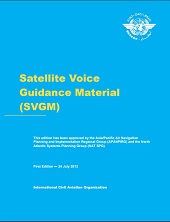For aircraft operating in airspace outside VHF communication range there are requirements for a Long Range Communications System (LRCS) such as HF and Satcom Voice (SATVOICE) for Direct Controller-Pilot Communications (DCPC). Airspace requirements may very and take precedence over the State of Operation or State of Registry. In some areas HF voice is the only LRCS available for ATC communications therefore most States in general will require at least 1 HF radio and 1 SATVOICE system. Aircraft operators must check with their regulatory authorities to find out what their State MMEL/MEL policies are. (For your convenience the FAA MMEL Policy Letter and the ICAO Satellite Voice Guidance Material is on the right side of this page.)
Just because an aircraft is equipped with Satcom Voice (or telephone) does not mean the system is qualified or approved for use as a LRCS. In order to be approved
for LRCS the transceiver must be approved for Safety Voice AND the telephone line must have priority and pre-emption features - this feature is included in
Air Sat One's Safety Voice or SATVOICE Services. SATVOICE service allows ATC (Air Traffic Control) to set telephone call priority levels of:
1) Emergency / Safety of Flight
2) Operational High / Safety of Flight
3) Operational Low / Safety of Flight.
Priority levels allow ATC to interrupt a lower priority phone call that may be in progress, this is known as preemption. Satcom Voice audio for the SATVOICE LRCS
must also be recorded on the CVR just like VHF or HF. Basically any communications with ATC must get recorded, both incoming voice from ATC and outgoing by the
flight crew. Typically SATVOICE communications recording is accomplished by routing the audio through the aircraft audio panel. Because of these requirements most
States DO NOT allow PORTABLE Sat Phone's for in flight communications with ATC.
Priority Level 4 is also available for calls going through the SATVOICE LRCS. Level 4 calls are for non-operational public phone calls. Level 4 calls are considered an additional service and there is a monthly fee to cover the special routing and handling of the additional priority level. This fee is rather expensive and airtime per minute is higher so it is recommended to have an additional telephone line and handset in the cockpit for non DCPC calls. Most Iridium and Inmarsat satcom systems include either additional telephone channels and/or a PBX system that allow the flight crew to share a telephone line with the cabin for public telephone calls. Calls for the aircraft operators dispatch or flight planning and considered public telephone calls.
SATVOICE dialing from ATC or the Air Traffic Services Unit (ATSU) to the aircraft can be made to the SATVOICE number by dialing the ICAO 8-digit octal code, also known as the Mode S Code, or by dialing the PSTN number. The PTSN number for Iridium is the same as the MSISDN number which starts with 8816 and the Inmarsat MSISDN which starts with 870. Assigning the ICAO code the SATVOICE system is performed by Air Sat One when service is activated or when the tail number is changed.







